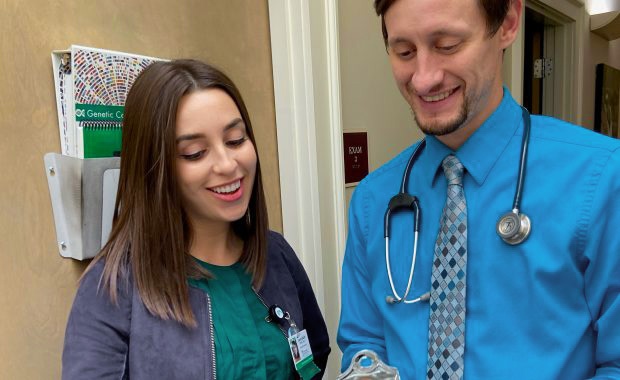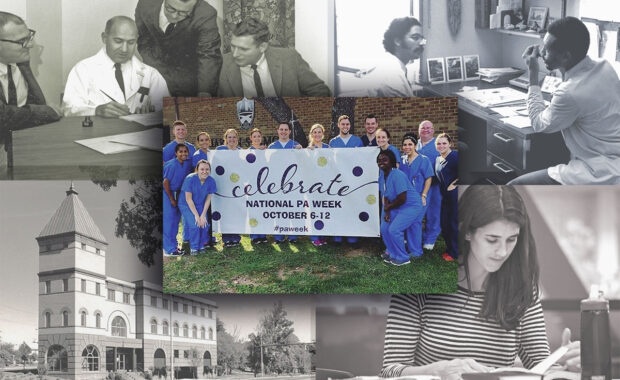What is a PA?
PAs (physician associates/physician assistants) are licensed clinicians who practice medicine in every specialty and setting.
Trusted, rigorously educated and trained healthcare professionals, PAs are dedicated to expanding access to care and transforming health and wellness through patient-centered, team-based medical practice.

A Vital Role
Established in 1967, the PA profession currently has more than 178,700 PAs practitioners in the U.S., engaging in more than 500 million patient interactions each year.
A Respected Profession
Prospective PAs can choose from among 308 accredited master’s degree level programs in the U.S. Programs take 3 academic years or 27 months, and PA candidates are also required to engage in 2,000 hours of clinical rotations as well as passing a certification exam, among other requirements.


A Winning Career Path
PAs practice in every specialty and work setting. Being a physician associate is regularly ranked among the top 5 healthcare, STEM, and overall jobs in the U.S.
Common Questions
PA education and practice emphasize patient education, preventive care, and chronic care management. PAs’ generalist medical training enables them to provide a wide spectrum of patient care and treat the “whole patient.” For example, during an appointment with a PA working in cardiology, in addition to discussing the patient’s heart issues, a PA might notice a skin condition and either treat it or refer that patient to a dermatology practice.
PAs make it easier for patients to get the care they need when they need it. A 2023 Harris Poll found that 90% of Americans say PAs improve access to care and make it easier to get an appointment. In addition, 93% of patients say PAs add value to healthcare teams, and 89% of patients say PAs improve health outcomes.*
* “The Patient Experience: Perspectives on Today’s Healthcare.” The research was conducted online in the U.S. by The Harris Poll on behalf of AAPA among 2,519 adults age 18+. The survey was conducted from February 23 – March 9, 2023. Interviews were conducted in English and Spanish.
PAs (physician associates/physician assistants) are licensed clinicians who practice medicine in every specialty and setting. Trusted, rigorously educated and trained healthcare professionals, PAs are dedicated to expanding access to care and transforming health and wellness through patient-centered, team-based medical practice.
PAs are educated at the master’s degree level. There are more than 308 PA programs in the country and admission is highly competitive, requiring a bachelor’s degree and completion of courses in basic and behavioral sciences as prerequisites. Incoming PA students bring with them an average of more than 3,000 hours of direct patient contact experience, having worked as paramedics, athletic trainers, or medical assistants, for example. PA programs are approximately 27 months (three academic years), and include classroom instruction and more than 2,000 hours of clinical rotations.
A PA’s medical education and training are rigorous. The PA school curriculum is modeled on the medical school curriculum that involves both didactic and clinical education training.
In the didactic phase, students take courses in basic medical sciences, behavioral sciences, and behavioral ethics.
In the clinical phase, students complete more than 2,000 hours of clinical rotations in medical and surgical disciplines, including family medicine, internal medicine, obstetrics and gynecology, pediatrics, general surgery, emergency medicine, and psychiatry.
PAs’ specific duties depend on the setting in which they work, their level of experience, their specialty, and state laws.
Generally, PAs can:
- Take medical histories
- Conduct physical exams
- Diagnose and treat illness
- Order and interpret tests
- Develop treatment plans
- Prescribe medication
- Counsel on preventive care
- Perform procedures
- Assist in surgery
- Make rounds in hospitals and nursing homes
- Do clinical research
There are more than 178,700 PAs who practice in every medical setting in all 50 states and the District of Columbia. They work in hospitals, medical offices, community health centers, nursing homes, retail clinics, educational facilities, workplace clinics, and correctional institutions. PAs also serve in the nation’s uniformed services and work for other federal government agencies, such as the Department of Veterans Affairs.
PAs are committed to team practice with physicians and other healthcare providers. Currently, most state laws require PAs to have an agreement with a specific physician in order to practice. These agreements were included in early PA practice acts 50 years ago when the PA profession was newly created.
Today, PAs are still held to these obsolete requirements despite the PA profession being well established, highly trusted, and essential to the U.S. healthcare workforce.
In 2017, the AAPA passed new policy called Optimal Team Practice (OTP). OTP occurs when PAs, physicians, and other healthcare professionals work together to provide quality care without burdensome administrative constraints.
To support OTP, states should: eliminate the legal requirement for a specific relationship between a PA, physician or any other healthcare provider in order for a PA to practice to the full extent of their education, training and experience; create a separate majority-PA board to regulate PAs or add PAs and physicians who work with PAs to medical or healing arts boards; and authorize PAs to be eligible for direct payment by all public and private insurers.
Yes. The PA profession is one of the fastest growing in the country. The Bureau of Labor Statistics projects the profession to grow by 26.5% 2022 and 2032, significantly faster than the average for all occupations. The demand for PAs is so high that three quarters of PAs receive multiple job offers upon graduation.
To learn more about becoming a PA, visit aapa.org/career central.
PAs are trusted healthcare providers. A 2023 Harris Poll found extremely high satisfaction rates among Americans who have seen a PA or have a family member who has seen a PA. The survey found that 90% view PAs as trusted healthcare providers and 91% believe that PAs are part of the solution to address the shortage of healthcare providers.*
At the practice level, there are likely more similarities than differences between PAs and NPs. However, there are two key differences:
- PAs are educated in general medicine, which offers a comprehensive view of all aspects of medicine. NPs must choose a “population focus,” e.g., pediatric nurse practitioner or women’s health nurse practitioner.
- PAs are trained to practice medicine using a curriculum modeled on medical school education. NPs are trained in the advanced practice of nursing.

